To characterize Beethoven's  Minor Quartet as teleology is to underscore its purposeful structural design, and to consider how Beethoven achieved its powerful underlying integration in movements comprising a scenario of dramatic contrasts. The work shows to a striking degree the dialectic of coherence and disjunction. Beethoven had specifically addressed these problems in the late quartets, and for each work had developed individual solutions. Far more radical than his middle period works—in aspects such as contrasted tempo, tessitura and material—the late quartets show how Beethoven solved the complementary, and at times intractable problems of coherence and integral design.1
Minor Quartet as teleology is to underscore its purposeful structural design, and to consider how Beethoven achieved its powerful underlying integration in movements comprising a scenario of dramatic contrasts. The work shows to a striking degree the dialectic of coherence and disjunction. Beethoven had specifically addressed these problems in the late quartets, and for each work had developed individual solutions. Far more radical than his middle period works—in aspects such as contrasted tempo, tessitura and material—the late quartets show how Beethoven solved the complementary, and at times intractable problems of coherence and integral design.1
Just how intractable those problems were in Opus 131 is revealed by the sketchbooks.2 In quantity alone, there are over two hundred surviving leaves of score sketches for Opus 131, which is more than for any of the other late quartets, and also more than for any other work by Beethoven. In content, the Opus 131 sketches show Beethoven's intense preoccupation in shaping the material, directed by a concept of unified structural design; and that the effort to realize that concept through working-out of details necessitated many painstaking stages of trial, adjustment and reworking.3 The existence of an integral groundplan for the whole work may be traced through the stages of its formative process; there are three drafts of the entire quartet in the sketch- books, which would indicate that Beethoven had a grasp of the whole design at a fairly early stage of the work's conception with
". . . each draft representing a stage in the evolution of the quartet as a whole, not just a single movement. Hence this most organic of the late quartets appears to have evolved through a uniquely organic process."4
If the score sketches show the stages of the compositional process through which Beethoven diversified facets of the material in different movements from his conceptual pattern in Opus 131, then the analytical process of tracing the unifying source of the work's diversity follows a reverse and complementary course of action—that is, of referring the diverse elements back to specific governing structural determinants. These will, in turn, offer an explanation of the subsequent formation and transformation of elements.5
The structural determinants which comprise the work's integral "core concept" are the fugue subject and answer. Beethoven's realization of those determinants is both selected and differentiated—that is, different parameters of the prime material, such as its motivic, harmonic or tonal components, may be realized in different contexts. They may also acquire, like the characters in a play, their own specific profile dependent on the tempo, key, tessitura and articulation of the context and movement in question.
There is accordingly a dialectical polarity of coherence and disjunction between the "core concept", as "Gestalt", providing the work's underlying source of unity, and the specific realization of some or more aspects of its multilayered potentiality. The "core concept" constitutes the integral plan of the work, and thereby provides its powerful sense of organic coherence. At the same time, the rich diversity of the work, its juxtaposed contrasts of key and musical content, results from the realization of selective aspects of the material, which in turn help define its specific characterization in individual movements. As Carl Schachter perceptively remarks:
". . . as a composition unfolds, it manifests a constant process of self-reflection. Foreground elements reappear in exact repetition or in variation, And of course the foreground also reflects—sometimes quite literally—the tonal structures of higher order whose elaboration and transformation it represents. In the course of foreground variation or of prolongation from level to level, a tonal prototype might be transformed into something of different or even seemingly opposite character; a stepwise progression, for example, might become a leap of a seventh or ninth. Yet the prototype and its variant have enough in common to enable a skilled listener to sense their connection."6
The "core concept" of the fugue subject and answer as fundamental "Gestalt" contains the total potentiality of the work in all its dimensions—the motivic cells and harmonic implications which will be realized at different levels throughout the work. At the highest level of tonal architecture, the key scheme of the movements reflects the specific characteristics of the prime material, notably the Neapolitan pitch  in the answer (violin 2, bar 6).
in the answer (violin 2, bar 6).
Example 1.

The keys of the seven movements may be seen in example 2.
Example 2.
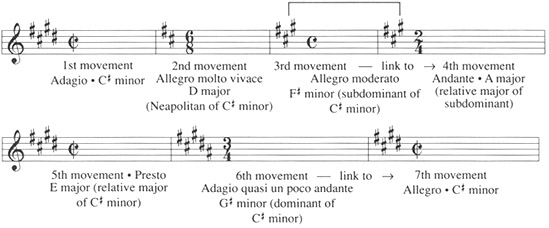
They constitute a clearly laid-out design of increasing numbers of sharps, enclosed by the outer movements of  minor.7 Only if the Neapolitan pitch in the fugue answer is understood to function as a structural determinant does the choice of D major, the Neapolitan key,8 for the second movement become logically comprehensible. Otherwise, had Beethoven wished to adopt a key signature with two sharps as part of the design of increasing numbers of sharps, then B minor is closer to the overall tonality of
minor.7 Only if the Neapolitan pitch in the fugue answer is understood to function as a structural determinant does the choice of D major, the Neapolitan key,8 for the second movement become logically comprehensible. Otherwise, had Beethoven wished to adopt a key signature with two sharps as part of the design of increasing numbers of sharps, then B minor is closer to the overall tonality of  minor than is D major. In addition, B minor would form part of a large-scale linear descent from
minor than is D major. In addition, B minor would form part of a large-scale linear descent from  minor through A major to
minor through A major to  minor. Yet that persuasive hypothesis gives way to a much more powerful compositional premise. Given that Beethoven chose precisely the right key (and in the late period, in a work of such mastery, there is no question of error), the reason for the choice of D major—and all other uses of the Neapolitan relation in the work, as in the sixth movement and the finale—must lie in the determining factor of the fundamental "Gestalt". Generalizing the argument, not only does the Neapolitan pitch in the fugue answer imply all other uses, at all levels, of the Neapolitan function throughout the work, but the realization of the fugue subject through the principal key areas of the first movement comprises a tonal design which is recreated at the highest level of organization—the key scheme of the work.9
minor. Yet that persuasive hypothesis gives way to a much more powerful compositional premise. Given that Beethoven chose precisely the right key (and in the late period, in a work of such mastery, there is no question of error), the reason for the choice of D major—and all other uses of the Neapolitan relation in the work, as in the sixth movement and the finale—must lie in the determining factor of the fundamental "Gestalt". Generalizing the argument, not only does the Neapolitan pitch in the fugue answer imply all other uses, at all levels, of the Neapolitan function throughout the work, but the realization of the fugue subject through the principal key areas of the first movement comprises a tonal design which is recreated at the highest level of organization—the key scheme of the work.9
The keys of the first three movements are implied in the fugue subject and answer. The subject is deliberately ambiguous: it opens and closes on the dominant pitch, yet delineates the tonic key (the key of the first and last movements); while the answer, which contains the striking Neapolitan pitch (the key of the second movement) opens and closes on the tonic pitch, while implying the subdominant key of  minor, the key of the third movement. The next use of the answer (cello entry, last quarter note of bar 12) sees a recontextualization of the second half of the answer, so that instead of implying
minor, the key of the third movement. The next use of the answer (cello entry, last quarter note of bar 12) sees a recontextualization of the second half of the answer, so that instead of implying  minor, it is now harmonized in A, the key of the fourth movement.
minor, it is now harmonized in A, the key of the fourth movement.
Example 3.

Beethoven's integration between the tonal goals of the fugue and the tonal planning of the work is revealed increasingly as purposive design. His use of prefiguration shows how a tonal reference in the fugue may anticipate its more extended realization in a subsequent movement. Both the key of the Presto, E major, and its compressed character are implied in the fugue, except that they are modified by its smoothly contoured characterization.10 The imitative entries between violin 1 and cello starting at the last quarter note of bar 20, show a change of texture, a contraction of the fugue subject to its first three notes and a rise of tessitura and dynamics towards E major.
Example 4.

If the approach to E major is effected through a contraction of the first half of the fugue subject, the approach to  minor, the key of the sixth movement, is achieved through the second half of the subject, also treated imitatively, between the first violin, cello and second violin.11
minor, the key of the sixth movement, is achieved through the second half of the subject, also treated imitatively, between the first violin, cello and second violin.11
Example 5.

References of tonal forward-planning in the fugue to the rest of the movements are encapsulated in the finale. However, the ordering of those references is affected by the structural function of the finale in the work and its relationship to the fugue. The finale is the recapitulation to the work overall and reverse complement to the fugue (as may be seen, for example, in bar 21 last quarter note, violin 1, where the third theme is clearly an inversion of the fugue subject; and also its variant in the cello, bars 170-72, in the recapitulation of the finale, is derived from the same source). This reverse complement relationship is underlined by the references to the keys of three of the preceding movements but in reverse order from the work itself—an elliptical stratagem for recapitulating the whole work through its tonal organization within the context of  minor, while at the same time underlining the reverse complement function to the fugue. Unlike a usual sonata movement, the finale operates on two levels of recapitulation. It has the normal recapitulation function within the sonata movement, of "grounding" the tonic key and bringing back the main thematic material in that key, usually in the same order but occasionally in reverse order.12 These aspects of recapitulation may be seen in the finale, where the second subject is given in the exposition in the relative major, E major, and in the recapitulation is restated in the tonic major,
minor, while at the same time underlining the reverse complement function to the fugue. Unlike a usual sonata movement, the finale operates on two levels of recapitulation. It has the normal recapitulation function within the sonata movement, of "grounding" the tonic key and bringing back the main thematic material in that key, usually in the same order but occasionally in reverse order.12 These aspects of recapitulation may be seen in the finale, where the second subject is given in the exposition in the relative major, E major, and in the recapitulation is restated in the tonic major,  major (bar 242). But at the larger level of recapitulation to the work, the finale also brings back references to earlier movements, and grounds them within the context of
major (bar 242). But at the larger level of recapitulation to the work, the finale also brings back references to earlier movements, and grounds them within the context of  minor. This helps account for the double statement of the second subject in the finale recapitulation, appearing first in the Neapolitan D major (bar 216), recalling the second movement and extending back to the Neapolitan pitch from the fugue answer; and then followed by a repeat of the second subject in the tonic major,
minor. This helps account for the double statement of the second subject in the finale recapitulation, appearing first in the Neapolitan D major (bar 216), recalling the second movement and extending back to the Neapolitan pitch from the fugue answer; and then followed by a repeat of the second subject in the tonic major,  major (bar 242). The reverse order references of keys in the finale are: E major, the second subject in the exposition (bar 56), which is the key of the Presto (5th movement); then the finale development begins in
major (bar 242). The reverse order references of keys in the finale are: E major, the second subject in the exposition (bar 56), which is the key of the Presto (5th movement); then the finale development begins in  minor (bar 78), the key of the third movement, and
minor (bar 78), the key of the third movement, and  minor also being the key of the third theme in the recapitulation (bar 182ff). In the recapitulation, as mentioned above, the second subject is first brought back in D major, the key of the second movement (bar 216), then restated in
minor also being the key of the third theme in the recapitulation (bar 182ff). In the recapitulation, as mentioned above, the second subject is first brought back in D major, the key of the second movement (bar 216), then restated in  major (bar 242). The Neapolitan pitch is also present at bar 329 and 332-34 before returning to
major (bar 242). The Neapolitan pitch is also present at bar 329 and 332-34 before returning to  minor, making the last main statement of the
minor, making the last main statement of the  /
/ appoggiatura, one of the prime figures of the work.
appoggiatura, one of the prime figures of the work.
The Neapolitan is one of the most important and far-reaching of the work's structural determinants. It is striking both within the context of the fugue answer and significant within the fugue itself. The last set of fugal statements in the first movement (beginning with the viola entry, last quarter note of bar 92) underlines this significance, and is analogous in function to the first level of recapitulation in the finale (i.e. recapitulation within the movement); what is being recapitulated is the fugue theme itself, and what is being grounded is the  /
/ appoggiatura on which the movement turns. While the subject (viola entry) is given at the octave below the initial statement of the subject at the outset of the movement, the answer (second violin) containing the Neapolitan is restated at original pitch. Moreover, the cello entry in augmentation (bars 99-107) purposefully modifies the line by a sfz on
appoggiatura on which the movement turns. While the subject (viola entry) is given at the octave below the initial statement of the subject at the outset of the movement, the answer (second violin) containing the Neapolitan is restated at original pitch. Moreover, the cello entry in augmentation (bars 99-107) purposefully modifies the line by a sfz on  , which clearly indicates the key of D at this point.
, which clearly indicates the key of D at this point.
Example 6.

The tonic of the movement,  , is recontextualized by the bass G as the leading tone of D major, resolving onto D (violin 1, bar 107). This figure constitutes the
, is recontextualized by the bass G as the leading tone of D major, resolving onto D (violin 1, bar 107). This figure constitutes the  /
/ appoggiatura of the fugue answer in inversion, as
appoggiatura of the fugue answer in inversion, as  /
/ within the passing context of the Neapolitan key of D. The temporary tonicization of D also prefigures the key of the second movement, which, as the key of D against the overall tonality of
within the passing context of the Neapolitan key of D. The temporary tonicization of D also prefigures the key of the second movement, which, as the key of D against the overall tonality of  minor, comprises a larger level of the appoggiatura
minor, comprises a larger level of the appoggiatura  /
/ .
.
The last appearance of the answer in the final set of fugal entries further reinforces the Neapolitan. Imitative entries between cello and first violin create a double verticalization of the appoggiatura— /
/ in the upper line,
in the upper line,  /
/ in the bass, both figures converging onto
in the bass, both figures converging onto  . The first note of each appoggiatura is marked for emphasis by a sf.
. The first note of each appoggiatura is marked for emphasis by a sf.
Example 7.
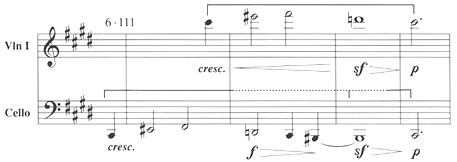
The sforzando bars (bars 113-16) are not only the climax of the movement, but are also its clarification. As the "structural downbeat",13 they enunciate and repeat the simultaneous statement of the subject appoggiatura  /
/ and its answer inversion
and its answer inversion  /
/ . This delineation of the appoggiaturas at the movement's most crucial point highlights their specific pitches and underscores their function as dissonant elements against, and in close proximity to the tonic. The appoggiaturas both characterize the prime material within the context of the first movement, and also provide an essential element in the underlying "Gestalt" for the movements to come. By verticalizing the two appoggiaturas, the structural downbeat encapsulates prime elements from both the subject and answer, and resolves them simultaneously.
. This delineation of the appoggiaturas at the movement's most crucial point highlights their specific pitches and underscores their function as dissonant elements against, and in close proximity to the tonic. The appoggiaturas both characterize the prime material within the context of the first movement, and also provide an essential element in the underlying "Gestalt" for the movements to come. By verticalizing the two appoggiaturas, the structural downbeat encapsulates prime elements from both the subject and answer, and resolves them simultaneously.
Structural determinants from the fugue subject accordingly derive from its components elements and their contour shape. The subject is made up of two complementary phrases—the first consisting of a four-note group, the first note being anacrustic to the three-note unit containing the appoggiatura  /
/ .14
.14
Example 8.

The elements comprising this "Gestalt" may be interpreted in two distinct but often interlocking ways: one is pitch content, which is retained in different contexts and at different levels, and may be projected through diverse rhythmic realizations in subsequent movements; the other is motivic shape, whereby the basic contour is retained, but individual component intervals may be altered according to tempo, key and other defining factors.15 From the specific requirements of individual movements—such as mode (major as distinct from minor), rhythm, tempo and register—emerge fine-grained modifications of the underlying schemata. In the second movement, for example, the major key requires a diatonic permutation of the four-note "Gestalt", obtained by the inversion of the  /
/ appoggiatura to
appoggiatura to  /
/ .16
.16
Example 9.

This underlying contour maps precisely into the opening of the second movement, as may be seen in Example 10.
Example 10.

The underlying contour of the opening of the other principal major key movement, the Andante, also exhibits subtle permutation of the same four-note cell. Here two stages are involved—from minor to major and from chromatic to diatonic.
Example 11.
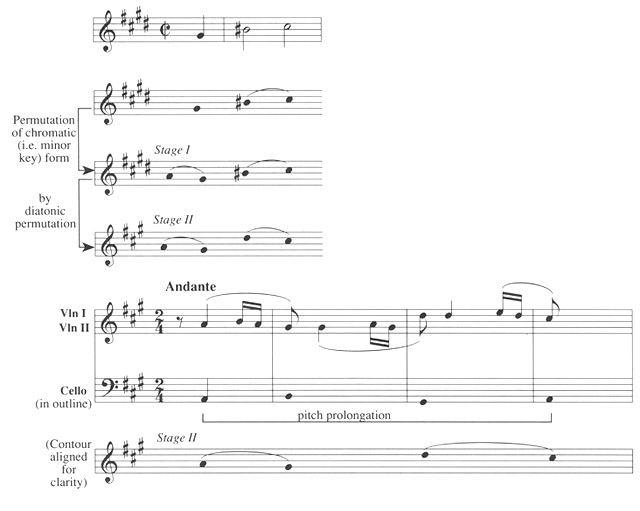
Just as the appoggiatura was one of the prime internal components in the first half of the fugue subject, so it also characterizes the second half of the subject, as the framing pitches A- .
.
Example 12.

The second half of the fugue subject resolves the four-note cell of the first half, but through the second appoggiatura creates dominant pitch prolongation. This dominant pitch prolongation underscores the intentional ambiguity of the fugue subject, whereby the initial statement in the tonic key is sustained through the prolongation of the dominant, its most suspensory pitch element; while the answer, prolonged through the tonic pitch, realizes the harmonic implication of the subdominant key,  minor. As well as its component elements of pitch content and contour shape, the intentional ambiguity in delineating tonal regions in the fugue subject and answer provides the resource for their subsequent deployment during the course of the work to come. "Planted" in the fugue, those implications are realized through successive movements, and are both recapitulated and resolved in the finale.
minor. As well as its component elements of pitch content and contour shape, the intentional ambiguity in delineating tonal regions in the fugue subject and answer provides the resource for their subsequent deployment during the course of the work to come. "Planted" in the fugue, those implications are realized through successive movements, and are both recapitulated and resolved in the finale.
The use of the second appoggiatura in shaping the contour of the fourth movement, Andante, is just as effective and imaginative as the use of the first one. It underlines coherence between the movements, while allowing each one its own individual characterization, phrasing and shaping at the musical surface. In the Andante the second appoggiatura, A- , is an invariant factor unlike the contour modification of the first appoggiatura. As part of the underlying "Gestalt" of the Andante, it retains the same pitches but is reinterpreted in the context of A major.
, is an invariant factor unlike the contour modification of the first appoggiatura. As part of the underlying "Gestalt" of the Andante, it retains the same pitches but is reinterpreted in the context of A major.
Example 13.
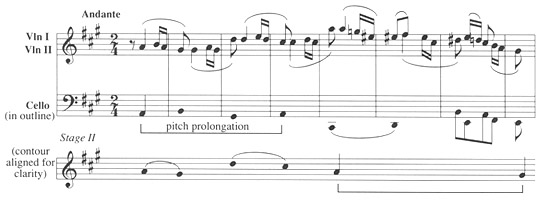
Elements of the prime material also map into the Presto, although in a highly compressed, almost skeletal way, making adjustment to the very fast tempo in  , and a shift from the fugue's upbeat emphasis to a square downbeat in the Presto.
, and a shift from the fugue's upbeat emphasis to a square downbeat in the Presto.
Example 14 shows a remarkable permutation of fugue subject elements in the Presto opening.
Example 14.
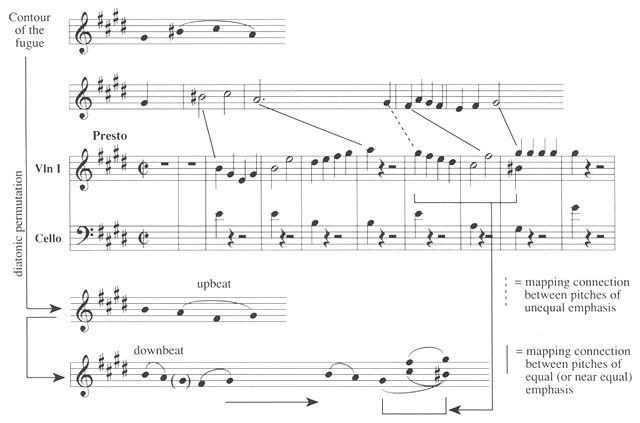
The dominant pitch,  , which formed the pitch prolongation of the second half of the fugue answer, returns in the complementary second phrase of the Presto opening. After the initial outlining of the E major triad at the outset of the Presto, its mediant pitch
, which formed the pitch prolongation of the second half of the fugue answer, returns in the complementary second phrase of the Presto opening. After the initial outlining of the E major triad at the outset of the Presto, its mediant pitch  is now reharmonized as the dominant of
is now reharmonized as the dominant of  minor. This striking turn of events is emphasized by a strong homorhythmic "forte" in the four instruments, in contrast to the "piano" dynamics of the preceding six bars. In addition, the
minor. This striking turn of events is emphasized by a strong homorhythmic "forte" in the four instruments, in contrast to the "piano" dynamics of the preceding six bars. In addition, the  /
/ appoggiatura of the fugue subject is inverted as
appoggiatura of the fugue subject is inverted as  /
/ , and forms a simultaneous inner part to the
, and forms a simultaneous inner part to the  pitch prolongation. This chromatic element, which had been rendered diatonic by the major key context in the first half of the phrase, now reasserts its presence in the second half as an inner line to the dominant pitch prolongation, and within the dominant harmony of the original key. The recontextualization of the pitch
pitch prolongation. This chromatic element, which had been rendered diatonic by the major key context in the first half of the phrase, now reasserts its presence in the second half as an inner line to the dominant pitch prolongation, and within the dominant harmony of the original key. The recontextualization of the pitch  , underlined by the inverted appoggiatura, refers back to the fugue. In terms of large-scale prolongational structures, it also refers foward to the sixth movement in
, underlined by the inverted appoggiatura, refers back to the fugue. In terms of large-scale prolongational structures, it also refers foward to the sixth movement in  minor, which is the minor dominant of
minor, which is the minor dominant of  minor, the key of the finale, and the work.
minor, the key of the finale, and the work.
The more legato "piacevole" E major theme in the Presto (bars 69-84) also provides a means of internal recapitulation. At the key signature change (bar 111) this theme is restated first in A major, then in D major. These are the keys of the preceding two major key movements, only in reverse order to the sequence of the movements themselves. By reiterating the keys of those movements, the two "piacevole" statements may be seen as referring back to the large-scale tonal planning of earlier movements, which in turn have their source in the prime material of the fugue. Through these manifold levels the "piacevole" statements acquire a much richer significance than just thematic appearances within the context of the scherzo. The choice of keys underscores the specific compositional rationale of creating coherence through intrastructural references between movements as well as interstructural coordination within the movement. Beethoven's use of such interlocking structural devices works both from small- to large-scale as well as large to small. These cross-references help establish an integrated network of relationships across the work to contrapose the dichotomy of disjunct characterization between movements.
The relationship of the finale to the fugue is both complement and resolution.17 It emphatically reconfirms the key of  minor by resolving the long-range dissonance of the Neapolitan and the tonal ambiguity of fugue subject and answer. Through resolution the finale metaphorically provides answers to the ambiguous or dissonant issues posed by the fugue. It achieves this through the complementary function of the fugue answer—the tonic-centered form of the fugue subject—which maps into the main material of the finale. Example 15 shows the similarity of contour between the fugue answer and the finale third theme and the extrapolated form of the underlying "Gestalt" of the finale main material.18 The slight changes of interval in the extrapolated form are significant in that they show how the ambiguity of the original "Gestalt" is now modified to an unambiguous confirmation of the overall tonality.
minor by resolving the long-range dissonance of the Neapolitan and the tonal ambiguity of fugue subject and answer. Through resolution the finale metaphorically provides answers to the ambiguous or dissonant issues posed by the fugue. It achieves this through the complementary function of the fugue answer—the tonic-centered form of the fugue subject—which maps into the main material of the finale. Example 15 shows the similarity of contour between the fugue answer and the finale third theme and the extrapolated form of the underlying "Gestalt" of the finale main material.18 The slight changes of interval in the extrapolated form are significant in that they show how the ambiguity of the original "Gestalt" is now modified to an unambiguous confirmation of the overall tonality.
Example 15.
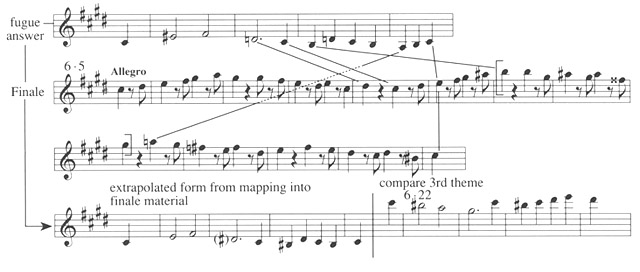
The finale is the resolution of the work in multidimensional ways. Its strongly articulated opening mirrors the fugue subject, but what was previously ambiguous or open-ended is now starkly clear tonally and powerfully articulated rhythmically. Whereas the second half of the fugue subject is framed by an appoggiatura falling to the dominant, the lowest line of the finale opening has an appoggiatura rising to the tonic, and strongly closing the gestural phrase. This emphatic opening with its appoggiatura rising to the tonic may be seen as a microcosm of the entire finale and its function in the work—that it resolves outstanding long-range dissonance and powerfully grounds the key of  minor. By comparing the fugue subject and answer with the finale opening, the latter further clarifies its function of resolution by being stated at the same register.19
minor. By comparing the fugue subject and answer with the finale opening, the latter further clarifies its function of resolution by being stated at the same register.19
Example 16.

Reinforcement of the tonic key and the drive towards closure may also be seen in the finale third theme (bar 21, last quarter note to bar 29). Clearly derived from the fugue subject, it retains the precise rhythmic pattern of the fugue subject, but in the finale allegro tempo. The finale third theme inverts the direction of the first half of the fugue theme; and the slight, but significant permutation of pitches in the second half has the first statement ending on the dominant, the second statement firmly closing on the tonic.
Example 17.
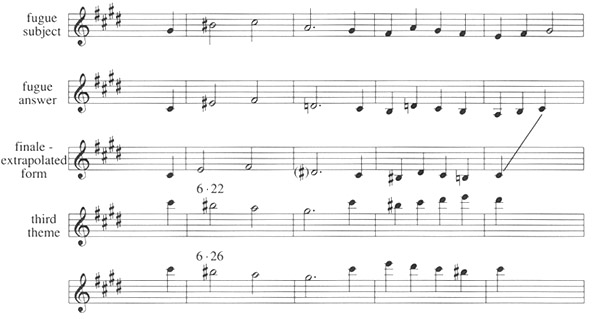
The relationship to the fugue is underlined by the first violin figure at bars 30-31, which is a clearly derived fugue reference, again at original pitch.
Example 18.

This is followed at bars 34-35 by the same figure at the octave above, which is at the tessitura of the third theme, and also of the main material of the first subject group (bar 5, second beat to bar 17).
The same configuration of third theme and fugue derivant returns in both the recapitulation and coda. In the recapitulation the third theme is initially modified in shape by octave displacement of the first downbeat,
Example 19.

and is set in contrapuntal stretto against the main material of the finale, with its driving "rider" rhythm, showing how textural complexity and intense rhythmic drive from the development spill over into the recapitulation. The finale is not only the resolution of the work, but resolution through recapitulation—and it is a sure indication of Beethoven's formal mastery that the recapitulation of the work is centered in the recapitulation of the movement. The recapitulation statement of the third theme is not in  minor, but in the subdominant
minor, but in the subdominant  minor. The subdominant implication from the fugue answer with its Neapolitan pitch is re-presented here in the finale recapitulation; and the repeat "doublet"20 in the two lower instruments has the fugue derivant as countersubject figure in the upper two instruments.
minor. The subdominant implication from the fugue answer with its Neapolitan pitch is re-presented here in the finale recapitulation; and the repeat "doublet"20 in the two lower instruments has the fugue derivant as countersubject figure in the upper two instruments.
The combination of third theme and fugue derivant makes one further appearance—in the coda (bar 277 last quarter note to bar 289). It reworks the elements in the recapitulation statement, only in reverse order. The thematic material is now clearly enunciated in  minor, and the countersubject figure at the "doublet" restatement (bars 286-87 and 288-89) is patently the fugue motif. Instead of preceded by the driving "rider" rhythm as in the recapitulation, the figure derived from the fugue, after the two statements of the third theme, now transforms back into the characteristic dotted pattern of the finale main material while retaining the fugue's motivic contour. As the figure drives towards closure, its component intervals are stretched under the increasing tension of the return to the opening first theme of the finale (bar 302).
minor, and the countersubject figure at the "doublet" restatement (bars 286-87 and 288-89) is patently the fugue motif. Instead of preceded by the driving "rider" rhythm as in the recapitulation, the figure derived from the fugue, after the two statements of the third theme, now transforms back into the characteristic dotted pattern of the finale main material while retaining the fugue's motivic contour. As the figure drives towards closure, its component intervals are stretched under the increasing tension of the return to the opening first theme of the finale (bar 302).
If the recapitulation brings back the subdominant implication from the fugue answer, then it also re-presents the Neapolitan, which was the source of long-range extant dissonance. It is significant that, just as the Presto "piacevole" statements referred back to the earlier major key movements, only in reverse order, so the finale recapitulation also brings back the fugue elements, but again in reverse order. The  minor statement of the third theme precedes the Neapolitan D major, in which key the second subject returns in the finale recapitulation. However, since the finale is itself a sonata design movement, it must not only re-present significant earlier features (and in this case "earlier" is earlier in the work as well as the movement), but it must also resolve them. Consequently, the second subject is repeated in the tonic major,
minor statement of the third theme precedes the Neapolitan D major, in which key the second subject returns in the finale recapitulation. However, since the finale is itself a sonata design movement, it must not only re-present significant earlier features (and in this case "earlier" is earlier in the work as well as the movement), but it must also resolve them. Consequently, the second subject is repeated in the tonic major,  major, showing the interlocking of recapitulation function both within the movement and within the work.
major, showing the interlocking of recapitulation function both within the movement and within the work.
However, the Neapolitan has one last card to play—a dramatic but pianissimo appearance in the coda (bars 329-30 and 333-35).
Example 20.

Like a "dramatis persona" who the audience thought had left the stage for good, its last unexpected appearance is instrumental in solving the drama. The  falls twice to
falls twice to  , emphasized by a sforzando. What this articulates is the resolution of the fugue prime material, the essential "Gestalt" interval of
, emphasized by a sforzando. What this articulates is the resolution of the fugue prime material, the essential "Gestalt" interval of  /
/ which in a sense opens up the entire work and all its diverse elements. Here, in the finale coda, the interval is closed off and reversed as
which in a sense opens up the entire work and all its diverse elements. Here, in the finale coda, the interval is closed off and reversed as  /
/ , so resolving it in its final categorical statement. The Neapolitan is now resolved, but residues of subdominant reference are present almost to the end (bars 370-83). These subdominant elements, however, are used plagally to underline the tonic major, while retaining a permutated version of the fugue material in augmentation.
, so resolving it in its final categorical statement. The Neapolitan is now resolved, but residues of subdominant reference are present almost to the end (bars 370-83). These subdominant elements, however, are used plagally to underline the tonic major, while retaining a permutated version of the fugue material in augmentation.
Example 21.

In a remarkable insight, Leonard Meyer discusses the idea of complexity in a great work, and says that no one performance (or explanation) of it may exhaust all its intellectual or expressive potential, but may reveal selective aspects for emphasis and attention.21 The value of such individual performances (and explanations) is the contribution they may make to understanding and enhanced experience. However, an index of the greatness of the work is that it not only supersedes, but—as elusive paradox—ultimately defies all explanations.
1The emphasis on coherence in the present discussion provides the counterweight to the extreme contrasts and juxtapositions in Op. 131; and it is precisely its integral coherence which prevents dissolution into unconnected succession or arbitrary dissociation. An interesting view of these contrasts is considered by Rey M. Longyear, "Beethoven and Romantic Irony," The Creative World of Beethoven, ed. Paul Henry Lang (New York: Norton, 1971), 145-62.
2See Douglas Johnson, Alan Tyson and Robert Winter, The Beethoven Sketchbooks: History, Reconstruction, Inventory (Berkeley, Los Angeles: University of California Press, 1985).
3Robert Winter suggests that the problems may in part be adduced to Beethoven's initially unsatisfactory attempts to reach a solution for the key of the fugue answer before finally adopting the subdominant, with its inherent elements of ambiguity; and in part to the "tug-of-war between large-scale design and its ramifications for specific movements." Robert Winter, "Plans for the Structure of the String Quartet in C Sharp Minor," Beethoven Studies, ed. Alan Tyson, 2 (London: Oxford University Press, 1977): 106-37. Extracted p. 129. Winter goes on to note that: "This quest for balance so evident in the sketches is an important contributor to the high level of integration in the finished work." Ibid., 129.
4Johnson, Tyson and Winter, Beethoven Sketchbooks, 482.
5This process follows the method adumbrated by Karl R. Popper in Conjectures and Refutations (New York: Basic Books, 1962) in which a theoretical construct is proposed and tested against facts (in this case musical elements and relationships), in order to explain challenging problems by means of designated criteria and frames of reference. It does not in any way suggest that the theoretical reconstruction replicated what Beethoven thought. Analytical constructs are hypotheses, to help explain the richness and power of great musical works. Maynard Solomon gives a salutary caution to distinguish creative process from working process, and, by extension, working process from recreative process. Maynard Solomon, "Beethoven's Creative Process: A Two-Part Invention," Beethoven Studies (Cambridge, Massachusetts; London, England: Harvard University Press, 1988), 126-38.
6Carl Schachter, "Rhythm and Linear Analysis: Aspects of Meter," The Music Forum 6/1 (1987): 1-59. Extracted pp. 36-37. Thematic transformation is also discussed in W.A. Dullo, "The Mysterious Four-Note Motif in Beethoven's Late String Quartets," Musicology 1 (1964): 10-15. Deryck Cooke, "The Unity of Beethoven's Late Quartets," Music Review 24 (1963): 30-49. Ekkehard Kreft, Die späten Quartette Beethovens; Substanz und Substanzverarbeitung (Bonn: Bouvier, 1959). Also, more generally, Rudolph R. Reti, The Thematic Process in Music (London: Faber and Faber, 1961).
7The key of C sharp minor was one of the most unusual in Beethoven's works. Was Joseph Kerman right in his intuition that C sharp minor was Beethoven's favorite middle period key of C minor, raised to a higher power? Joseph Kerman, The Beethoven Quartets (New York: Knopf, 1967), 341.
8The term "Neapolitan" is used to denote the root of the triad on the flattened supertonic, although the Neapolitan 6th is the first inversion of that chord.
9The recreative hypothesis finds substantiation from the creative process. In the earliest score sketch for the entire quartet, Beethoven laid out the overall tonal plan for the work and outlined a conceptual scheme for continuity between movements. See Robert Winter, ibid., particularly pp.114-15 and 120.
10One of the innovative features of the fugue is precisely this dialectical interplay between the outlining of tonal goals and the blurring of their articulative delineation. See Amanda Glauart, "The Double Perspective in Beethoven's Opus 131," Nineteenth Century Music 4 (1980-81): 117.
11It is of considerable interest that the following section in E flat minor (bars 45-53) is enharmonically D sharp minor, the dominant of G sharp minor. This key is confirmed at the end of the section (bar 54), as the goal of the preceding crescendo, and now uses the first half of the fugue subject in imitation, then rhythmic diminution between cello and violin 1.
12One of Beethoven's most innovative treatments of sonata recapitulation occurs in the last movement of the E minor Rasoumovsky Quartet, Op. 59, No. 2. Not only do the subjects occur in reverse order, but the second subject in the tonic is stated in the development (not recapitulation), preceded by a "faux repris" in B flat major. Since the second subject is brought back in the development. it does not appear in the recapitulation. There are also some aspects of an exchange function between the development and the recapitulation, since the latter shows developmental features. It is also of particular interest that both the first movement and the finale of Op. 59, No. 2 utilize striking Neapolitan elements, first articulated as the repeat of bars 3 and 4 at the beginning of the first movement. These are discussed in David Epstein, Beyond Orpheus; Studies in Musical Structure (Cambridge, Massachusetts; London, England: MIT Press, 1979), 214-15.
13Edward T. Cone, Musical Form and Musical Performance (New York: Norton, 1968), 24-25.
14Part of the symmetry of the fugue subject derives from two complementary lower voice appoggiaturas as a palindrome.

15Carl Schachter's comments are particularly apposite. Supra, note 6.
16The crucial interval of the fugue answer,  /
/ , is inverted in the second movement to
, is inverted in the second movement to  /
/ , or more precisely, as a mordant,
, or more precisely, as a mordant,  /
/ /
/ .
.
17Integration between the first movement and the finale of Op. 131 in a unified conceptual scheme is noted by Charles Rosen, The Classical Style: Haydn, Mozart, Beethoven (New York: Norton, 1972), 403.
18The finale is a rigorously treated sonata movement. The first subject group has three components: the opening gesture (bars 1-5) is the first of these; the main theme (bars 5-17) is the second component; and the third theme of the first group, referred to in brief as the third theme, begins on the last quarter note of bar 21 and continues to bar 29, and is then repeated with varied scoring. The contrasting second subject in the relative major, E major, occurs at bar 56.
19For registral closeness, see also the openings of the fourth movement, Andante, and the sixth movement, Adagio.
20Kerman, ibid., 201-204.
21Leonard B. Meyer, Music, the Arts, and Ideas: Patterns and Predictions in Twentieth Century Culture (Chicago and London: University of Chicago Press, 1967), 33-37; 46-48; 53.


